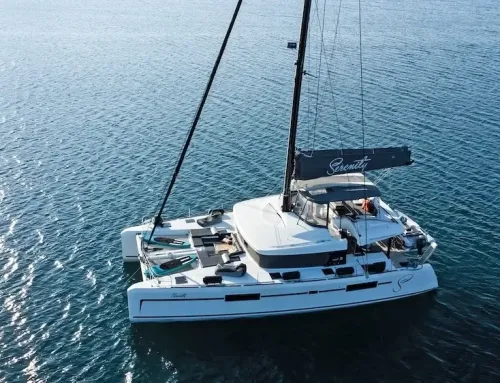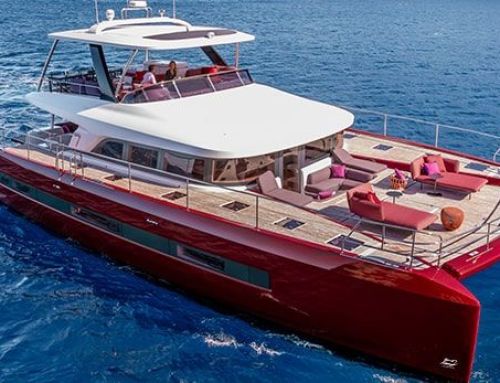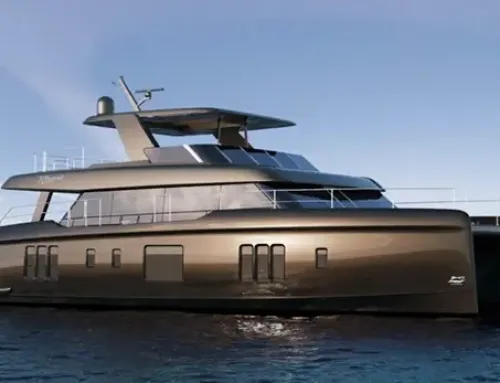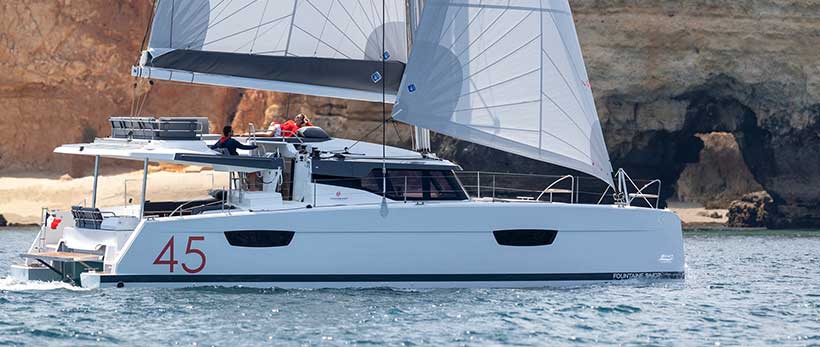
Review Fountaine Pajot Elba 45
The French company Fountaine Pajot is somewhat of an oak tree in the industry, having a history that dates back to the company’s establishment in 1976. While new catamaran brands are cropping up like mushrooms, Fountaine Pajot has been there since 1976. It is also one of the major cat builders in the industry, having shipped over 600 boats across the world in 2018. The brand-new Fountaine Pajot Elba 45 will take the place of the Helia 44, which has been in production for seven years, and is designed to become the yard’s next best-selling boat. As a result of this, it is not a paradigm-shifting breakaway model; rather, it is a reliable, trustworthy, and well-thought-out staple model. Not without reason, more than one hundred of the boats had already been purchased before the first hull had ever been launched into the sea.

Fountaine Pajot Elba 45 Catamaran Charter Croatia 3
The Design and Building Process
Olivier Racoupeau, the designer of the Fountaine-Pajot Elba 45, started with a blank slate after more than 150 meetings and hundreds of hours of labor. The Fountaine-Pajot Elba 45 is intended to take the place of the older Helia 44. The brand-new hull has a smaller chine in the aft portion and a redesigned transom, which together contribute to a reduction in drag that is 10 percent lower than that of the Helia. Racoupeau shared with me his thoughts by saying, “It may not seem like much, but for us, that’s a significant issue.” The end result is improved performance at medium to high speeds as well as increased efficiency while motoring; all of this is accomplished in a hull that is just 6 inches longer than its predecessor and 6 inches beamier.
In addition to that, Fountaine-Pajot has not deviated from its winning formula of slightly aft-raked bows and fixed stub keels below the waterline in order to improve the boat’s performance when sailing into the wind. According to the “flagship director” of the company, Yves de Kerangat, the keels are only glued into a specifically constructed recess in the hulls. There are no keel bolts, which means that in the case of a collision or a grounding, the boat will not be compromised by the loss of the keel bolts. During the layup process, a combination of polyester and vinylester is infused under glass, and an epoxy primer is applied on top as a final layer to prevent blistering. The process is called vacuum infusion.
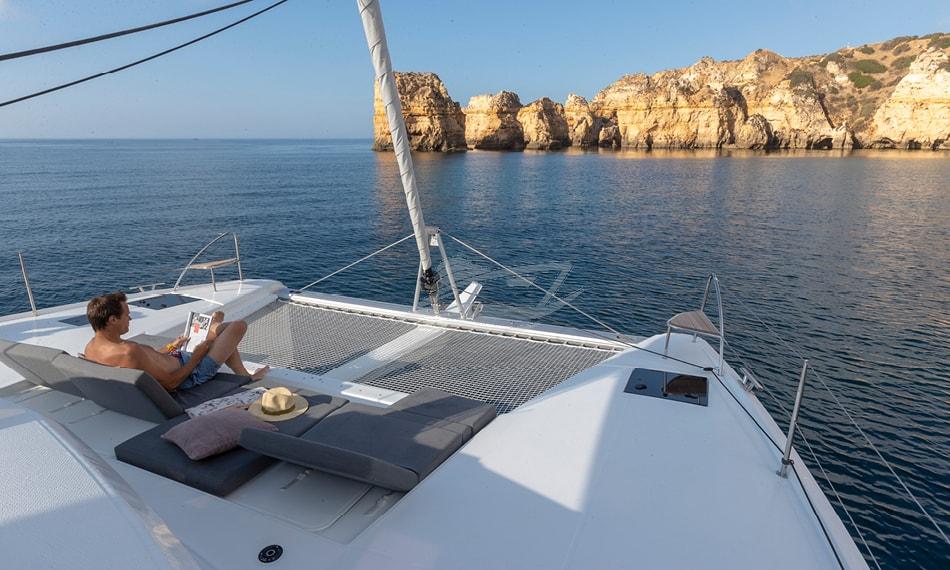
Fountaine Pajot Elba 45 Catamaran Charter Croatia 9
On deck
Instead of offering this boat with a complete flybridge, Fountaine Pajot has opted to provide a bulkhead helm position along with some low-profile lounging area on the coach roof. This decision was made in order to maximize interior volume and save weight. Why was “resistance” used? The additional room and prestige that a flybridge provides may be appealing to some people; nevertheless, because it adds a significant amount of weight to the upper decks, the designer is required to increase the height of the boom. Because of this, the center of effort is moved higher up, which in turn increases the heeling moment and necessitates a mast that is higher.
As it stands, the 45’s helm provides a kind of halfway house in which the person at the wheel can still stay involved in life on the aft deck below, via sightlines through the ladder up to the coach roof. This is possible because the 45’s helm sits in the same location as the ladder that leads to the coach roof. Additionally, there is a full 109 square feet of cushion area up top, where crew members can either keep the helmsperson company or simply view a sunset.
This contemporary-looking cruising catamarán has high topsides and bows, and it has a noticeable reverse sheer, which serves to decrease the size of the saloon windows while at the same time creating more useable space below. In terms of aesthetics, this catamarán has a modern appearance. A smart skirt has been added to the transoms at the stern of the vessel, making it much simpler to step onboard from the tender or when the vessel is alongside another vessel. Another nice feature is an optional electrically operated bathing platform that spans the entire width between the hulls and provides a convenient way to launch and retrieve a 10 foot 10 inch tender, thereby eliminating the need for unsightly davits. This platform is available as an add-on for an additional cost.
The rig is suitable for use in ICW waters and is representative of a fairly conventional catamaran design, with the 59-foot-and-five-inch mast stepped on the leading end of the coach roof. The genoa sheets are led to a set of tracks situated close to the centerline and within reach of the cockpit for simple control and precise trim angles. The mainsheet is led to a traveler that is mounted aft of the helm and lounging area. You can easily manage sheets, halyards, and reefing lines thanks to the presence of three Lewmar 50 winches in the rope-handling pit that is located right in front of the wheel. All lines return here after being lead back there.
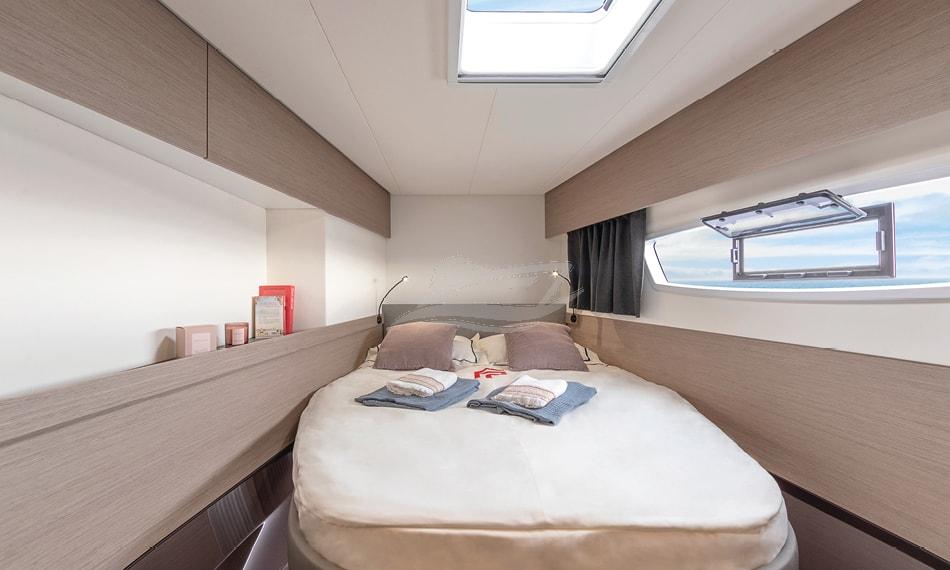
Fountaine Pajot Elba 45 Catamaran Charter Croatia 13
Accommodations
When compared to the first-generation Helia 44, the interior design team at Racoupeau and Fountaine Pajot has made a number of important improvements, most notably with regard to the huge saloon that spans 180 square feet. For instance, where the Helia had a horseshoe-shaped galley aft and a deep, dedicated chart table forward to port, the new boat leaves this space largely uncluttered, with the galley now running along the port side of the saloon, where it is punctuated by a set of stairs leading down into the cabins that are located in the hull. Additionally, the galley now runs along the starboard side of the saloon as well. Additionally, the chart table has been removed, and the navigational instruments have been moved to a cabinet that is located next to the sliding door that leads to the cockpit. Racoupeau offers the following statement as an explanation for the decision: “From our own personal experience, we realized that we utilize the chart table less and less.” We go there to get knowledge, but we don’t sit down and get any work done as we used to in the past.
Both a “Maestro,” or owner’s, version and a charter-friendly “Quatuor” setup are available for the yacht’s interior. The “Maestro” version is a double cabin that takes up the entirety of the port hull and features a fold-out TV, dressing table, copious clothes storage, and a large shower room and heads. The “Quatuor” setup features four cabins and four heads. Both have a crew bunk in the bow on the starboard side, as well as space for a crew head on the port side. In addition to it, there is enough for a sail storage. The finish that comes standard for the furniture is a light grey wood, and the carpeting and upholstery may either be neutral or dark oak.
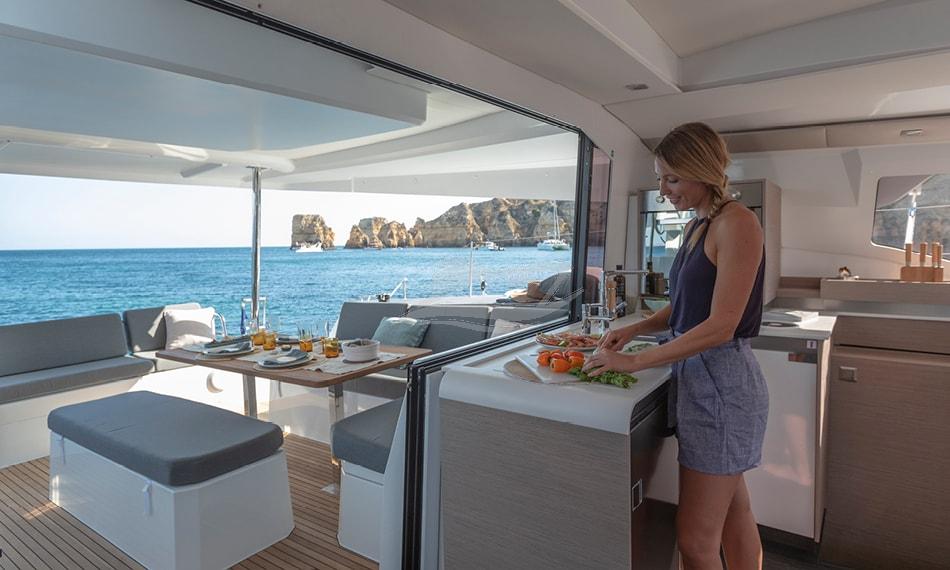
Fountaine Pajot Elba 45 Catamaran Charter Croatia 19
Under sail
An clever hook that is positioned on the head car of this boat makes the work of raising the main sail much simpler by providing a 2:1 purchase as it draws the sail up the mast track. This means that you don’t have to lose any time bringing the sails up with this boat. We discovered that the FP Elba 45 was able to easily maintain 7 to 8 knots of boat speed when beating into roughly 12 knots of true wind at an apparent wind angle of 45 degrees. This was accomplished with the fully battened main sail and the conventional 120 percent genoa.
She benefited from the wind and rolled along smoothly. We were only able to test a reaching sail, so we missed out on testing a running sail, which would have really shed some light on the situation. According to Fountaine Pajot, the bigger genoa means there is less of a requirement for other sail configurations, such as a specialized Code 0. On the other hand, a central longeron protrudes beyond the bow, serving as a tack point for any canvas that may be used.
Under power
The Fountaine Pajot Elba 45 is a quiet and efficient powerboat since it is equipped with a pair of 40-horsepower Volvo D2 saildrives that are hidden away in its two transom compartments. You also have the option to upgrade to a pair of units with 60 horsepower each, which would be a great option if you plan to spend a significant amount of time driving. The typical propeller is a 17-inch-diameter three-bladed device that is fixed. Nevertheless, you also have the option to upgrade to an 18-inch Volvo folding prop.
Because it is controlled by a regular Volvo dual throttle, it is simple to handle at moderate speeds in the area immediately surrounding the dock. At a rpm of 2,000, we were able to easily get over 7 knots, and at a rpm of 3,000, we were able to achieve over 9 knots.
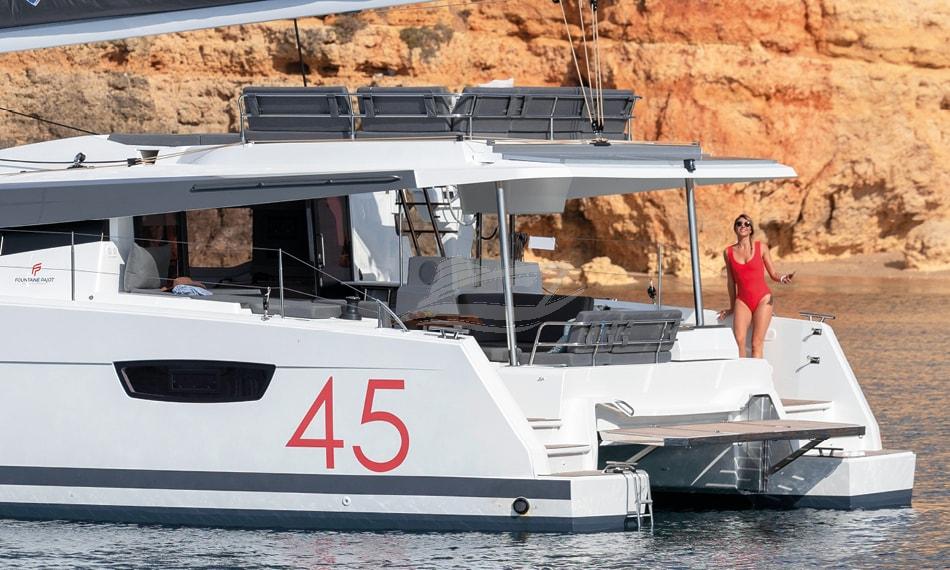
Fountaine Pajot Elba 45 Catamaran Charter Croatia 20
Our Conclusion
Again, Fountaine-newest Pajot’s design takes the place of its well-liked Helia 44, and it does so by occupying a true “sweet spot” in terms of a LOA and displacement that makes it suitable not only for families who enjoy idling around the harbor, but also for those who have aspirations of going on longer cruises. When compared to the Helia, the modifications that were made to the Elba 45 are well-thought-out and make the boat more efficient while also improving its overall performance. This might very well be the perfect boat for you if you are seeking for an exciting and secure sailing vessel that will allow you to look after your family in luxury.


